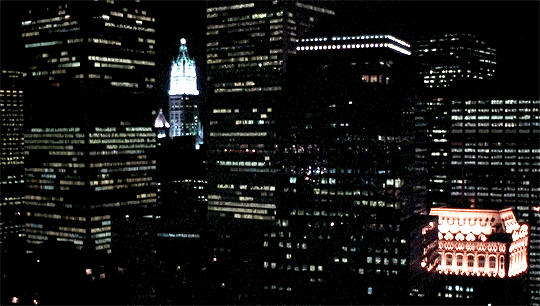
1980
The Void of the 80s'
In today’s hyper-individualized, deregulated, and fractured world, one begins to question what, if any, of our collective actions are actually connected with discernible moral scruples. As the purpose and function of our globalized world becomes increasingly harder to discern, helplessness, nihilism, confusion, and listlessness all reign at the highest and lowest levels of our society.
There is no doubt that we are living in the beta stage of the modern world, and perhaps this explains why the temperament and values of our society are so difficult to precisely identify and explain. In this period of flux, in order to move towards understanding where we are positioned as a collective, it is necessary to parse as much information as we can from the flux of the ideologies that surround us. Dissolution of a knowable, familiar reality began to erode in the 80s, lockstep with the global deregulation of markets and capital. The dominant ideology of the ‘free market’ in all its iterations that characterizes so much of our world today found its genesis in the ‘decade of greed’ that was the 80s.
A significant part of any ideology is its representation in culture and art, and for the 1980s, its memetic representation is in the both the characters Gordon Gecko and Bud Fox in Oliver Stone’s Wall Street. Gecko was the personification of unchecked capitalist greed, and Fox the hapless victim to the intoxication of the great materialistic benefits achieved through the relentless pursuit of profit unbound by any semblance of morality. Oliver Stone dichotomizes the tension between good and evil in the human condition, with Gecko embodying evil and Fox good. In many ways, this film was a symbolic representation of this dichotomy within the context of the rampant growth of the neoliberal, capitalist mindset and the nihilism that it bred across different sectors of the American workforce. The 80s also saw the rise of globalization and the rise of class inequality across the United States and Western Europe, and in many ways Wall Street told a story of what was transpiring in Western World at large.


"There is no doubt that we are living in the beta stage of the modern world"

Wall Street came out in 1987, and in many ways its successor was one of the most polarizing and controversial books in literary history, Bret Eaton Ellis’ American Psycho. Ellis’ book sought to represent the landscape of the 80s, for all its ills and misgivings. The cultural critique Ellis offered of the 80s as an era were largely unknown and unacknowledged by contemporaneous critics, as the extreme misogyny, violence, and superficiality that American Psycho depicted was zeroed in on for being highly offensive instead of satirical. In the age of AIDS, new wave feminism, and death squads, many felt American Psycho was just simply insensitive, and that Ellis was basically relying on shocking, near pornographic depictions of sex and violence to sell his novel. While there’s no question that American Psycho is a brutal, and at times hideous read, but underneath the surface lies a brilliant and scathing critique of the malaise of the 80s.
Bret Ellis started writing American Psycho in the spring of 1987, as he moved into an apartment on 13th street in the East Village. The massively successful author of Less Than Zero and Rules of Attraction, Ellis was a celebrity beyond the confines of the literary world when he began American Psycho at only 23, rubbing shoulders with the artistic elites across many different fields. The building he rented had a special, uniquely New York aura to it because of the fact that Tom Cruise had lived there while the area itself was still a desolate one and untouched by brushes of gentrification. When Ellis moved in, there were still no million-dollar apartments in the East Village in 1987, and multi-colored crack vials littered the streets. It was a raw and unsafe, but the area came with its own authentic, ineffable charm.

The spring that Ellis began writing American Psycho in was in fact the end of era and a start of a new one within the decade, as the funeral for Andy Warhol took place on April 1st 1987. New York lost the seminal figure and champion of the pop art movement, and there was a massive void left for the artistic community to fill. New York, especially its artistic community, was in a time of massive flux, searching for a new purpose, direction, and identity. Bret Ellis selected the day of Warhol’s funeral as the day when American Psycho begin, titling the first chapter ‘April Fools.’ One reading of this decision suggests that this is a not so subtle nod to Ellis’ feeling that one of the chief features of the era he was trying to encapsulate was the difficulty in discerning between imagination and reality, that the world he lived in was hypnagogic, mystical and dreamlike. Or, perhaps Ellis was offering a hint that the novel that one was about to read is perhaps not a reliable one – perhaps his novel is all a dream and a conceptual representation of the collective sensibility of a consumer yuppie culture that filled the void that the era of Warhol left. Whatever he intended, there’s no question that this start date was intended to reflect the splintering and disaffection of the end of the 80s.

When Bret Ellis looks back at the time he spent writing American Psycho, it can perhaps be best summarized with one word: surreal. In the novel, this world is described from the perspective of the infamous character that Ellis created: Patrick Bateman. Both men shared an illusory and yet distant relationship with the world of the 1980s that they were both appalled and fascinated by. Ellis and Bateman felt a mutual desire to connect with the world of the 80s, and yet both simultaneously shared disgust for the world that had created them. In many ways American Psycho was Ellis’ personal rebellion against what was expected of the youth in his generation. The depiction of the 80s in American Psycho was a reflection of Ellis’ refusal to believe that within the ephemeral of 80s, there was no other choice than to be subsumed by the culture and lifestyle of the era. He wanted to believe there was a way out of the fake world that he saw around him, but all he found was a frustration with the gilded reality. Ellis, and the Bateman character that was a conduit of his innermost feelings and perception, were ultimately simultaneously seduced and repulsed by the greed and excess of an era.
A significant inflection point in Ellis’s conception of the 80s in American Psycho came when he was having dinner with the older siblings of his classmates from Bennington College on the Lower East Side, in late 1987. All of these men were employed in the finance sector, just as the fictional Patrick Bateman was. During his research, Ellis began to grow frustrated with their evasiveness in regards to what they really did in their offices and what actually transpired at their lucrative finance jobs. These men were neither especially bright, charming, or perceptive, but they had absurdly high paying positions at very young ages. At this dinner, it dawned on Ellis that their jobs were not of central importance, and to tap into what they valued he needed to change his locus of attention. He noticed that they didn’t really care about their jobs, and they were only interested in showing off their materialistic lifestyles, their Armani suits, expensive tans, sculpted physiques, expensive haircuts, summer homes at the Hamptons, experiences at the hippest restaurants in New York. Everything else below the surface seemed to fall by the wayside in 80s culture. This superficiality was essentially a larger metaphor for the 1980s itself – driven by lifestyle competition, which came at the expense of tradition, deeper values, and meaningful human connection. The free market ideology that dominated these men’s work life was seeping into all areas of their life and all sectors of society, and their value systems were slowly morphing into just a different manifestation of unbridled, ruthless competition in the free market.

"This superficiality was essentially a larger metaphor for the 1980s itself – driven by lifestyle competition, which came at the expense of tradition, deeper values, and meaningful human connection. "

What was this society that had led Ellis to become such a successful author? Why did he want to escape it? Where was there to even go? The only thing that made sense in the world he was living in is the engine that now totally drives New York City today - money. This idea of money and profit and all its permutations being the chief value of society might be ubiquitous in 2017, but it was still in its nascent stages in 1987.
Bret Ellis stopped by the set of Wall Street late in 1987 to smoke a cigarette with Charlie Sheen, who was playing Bud Fox. Bret Ellis describes Sheen’s character as the representation of everyone in the 1980s. The seduction of Bud Fox by Gordon Gecko, to Ellis and many of his peers, was the most real, powerful and gripping portion of Oliver Stone’s film. In a way, this seduction was gripping everyone in the era, and the permutations of this intoxication continued to play out as the 80s dragged on.
The reason why Wall Street only tells half the story, and American Psycho picks up where it left off, is that the second half of the film, the redemptions of Bud Fox, never came true. With the real Bud Fox’s and Gordon Gecko’s of the world, there was no day of reckoning, no higher value to subscribe to, and no version of morality that ever managed to replace free market, unfettered capitalism and its myriad consequences.

American Psycho was the surreal corrective to Wall Street, the nihilistic satire and depiction of the logical outcome where every Bud Fox was heading. Ellis wrote a novel that poignantly critiques a society obsessed with its surface, one that is willing to go to excessive lengths to ignore anything that hinted at something darker lurking beneath its shiny exterior. The brutal deaths, rapes, are excruciating and difficult to read, but they are the representations of the frustration that Ellis felt living in world that he could understand, and a world that could not understand itself. Perhaps the most basic components of human life, suffering, aren’t actually real within the context of the fake world created in the novel, but perhaps they were not any more real than anything else in the bleak reality of the 80s. Herein lies the dark thesis of American Psycho.
Understanding the 1980s, and its connection to the world that we all inhabit today, feels very pertinent. The spiritual chaos wrought by hyper-capitalism and the free market belies the promises of social order and collective gain that the 1980s promised. American Psycho is just one amongst many works of art that highlights and strives to understand the very real struggles of the human condition in an age of flux. The surreal temperament of modernity depicted by Ellis still very much exists in 2017.
Recommended For You

